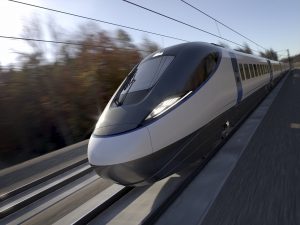HS2 Ltd has published it’s Net Zero Carbon Plan, which sets out how HS2 will achieve new carbon reduction milestones, support the decarbonisation of the UK construction sector and reduce the carbon footprint of the programme.
The report details that HS2 trains will be powered by zero carbon energy from the first day of operation, offering a cleaner alternative to long distance car journeys and domestic flights, supporting the government’s 2050 target to tackle climate change. This commitment will play a key part in HS2 Ltd’s aim to make the project net zero carbon from 2035 and features targets incl. diesel-free construction sites and major reductions in carbon emissions from the steel and concrete used to build the railway.

HS2 Ltd plan to work towards being zero carbon from 2035 through the following new targets:
- Using 100% zero carbon electricity generation to power its trains – making journeys on HS2 zero carbon for emissions from ‘day one’.
- Introducing the first diesel-free site in 2022 – and stop using diesel on all sites by 2029.
- Working with supply chain partners and industry peers to set ambitious new science-based targets in 2022 to tackle carbon emission ‘hotspots’ year-on-year as HS2 is built.
- Cutting emissions from concrete and steel by 50% (tCO2e/t) by 2030 compared with 2021 levels.
- Investing in innovation and forming partnerships to speed up ways to cut emissions in HS2’s supply chain.
- Cutting emissions from sources HS2 owns or controls and indirect emissions from electricity production.
- Offsetting residual carbon emissions that cannot be eliminated as HS2 is built, maintained and operated from 2035. This includes looking at ways to capture and store carbon emissions using nature-based interventions such as planting new trees to absorb carbon dioxide.
You can access the plan here: HS2 Net Zero Carbon Plan 2022
HS2 is also working with the supply chain and research organisations to pilot and implement low carbon materials, alternative fuels, renewable energy and new construction methods through the HS2 Innovation programme.
In design, highlights include:
- cutting carbon emissions by 45% by redesigning the Chilterns tunnel south portal;
- Interchange station in Solihull becoming the first railway station in the world to achieve BREEAM ‘outstanding’ for its eco-friendly design;
- redesigning the roof at Old Oak Common station, west London, to reduce the amount of steel by 27%, cutting embodied carbon;
- cutting the amount of concrete and steel needed to build the Wendover Dean viaduct, Buckinghamshire, saving 7,433 tonnes of carbon – equivalent to 20,500 return flights from London to Edinburgh; and
- reducing the depth of the paving in the public realm at Curzon Street station by 38% to cut embodied carbon.
In construction, highlights include:
- trials of a new low carbon concrete product that cuts carbon emissions by 42% compared with standard concrete;
- a world-first pilot scheme using recycled wind turbine blades to reinforce concrete – cutting carbon emissions for reinforcement by up to 90%;
- using 3D reinforced concrete printing onsite, cutting quantities of concrete, reducing carbon emission by up to 50% and cutting deliveries by truck;
- pioneering the UK’s first electric forklift at a major construction site – achieving the same performance as a conventional model with zero emissions; and
- using Clean Air Gas Engine technology, initially in site welfare units, to cut carbon on construction sites.
Discussing the report, Minister Andrew Stephenson said “We know that the climate crisis demands urgent action and these commitments from HS2 are vital steps towards achieving cleaner UK travel. HS2 is a once-in-a-lifetime investment and we want to ensure the country’s biggest infrastructure project, supporting thousands of jobs and businesses, is underpinned by the Government’s ambitions for a greener transport and construction future.”